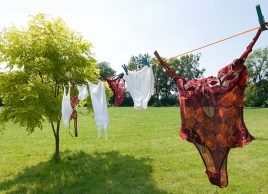Putting it all on the line
Discover the eco and health benefits of hanging laundry out to dry

Source: Best Health Magazine, Summer 2008
In many parts of North America, the decline of clothesline use has mirrored the rise of the electric dryer. Also, since the 1970s, many communities have restricted clotheslines on the grounds that they are unsightly and might decrease property values. (Developments with such bylaws represent the majority of new homes across the country.)
But as concerns about global warming mount, clotheslines and drying racks are emerging as a modern badge of green citizens. Vancouverite Elizabeth Johnson is one of them. She co-founded Let’s Hang Out, a small but passionate network of Canadians promoting “natural” laundry drying as a low-cost contribution to the environment. Hanging laundry on a clothesline even has health benefits: It’s both physical and a good excuse to take in some fresh air; it can even be meditative, says Johnson. “Many people have never experienced the pleasure of hanging laundry.”
Politicians are catching on. In April, for example, Ontario announced an end to the restrictions currently in place in housing developments, permitting the use of outdoor clotheslines. (Several U.S. states have recently done the same, under the banner of the “Right to Dry” movement.)
A standard clothes dryer consumes about six percent of the total electric energy used in an average Canadian household each year. Hanging just 25 percent of laundry over this time would cut the electric bill and reduce greenhouse gases and air pollution by about 200 kilograms.
Canadians are getting on board. When Montrealer François Pilon, a.k.a “Mr. Clothesline,” started his business 20 years ago, clotheslines were decidedly “out.” But in the past five years, he says, he’s installed about 800 energy-saving lines each summer. “They’ve become a green solution, a lifestyle.”
Clothesline tips
A clothesline revival is taking the humble device from a gadget only Grandma could love to a backyard symbol of green living. Here’s what you need to know to add one to your household. Best Health compiled this list of clothesline tips with the help of François Pilon, a.k.a. Mr. Clothesline, who has been installing clotheslines for about 20 years through his business, Corde à linge Montréal.
Buying a clothesline
- The pulley: Choose a ball-bearing pulley, which won’t squeak.
- The cord: Select a polyester cord, if you prefer a non-metallic cord. The alternative—polypropylene cords—tend to dry in the sun and decompose into dust. Hemp rope, which withstands rot and mildew, is a another popular alternative.
- The poles: Cedar poles are not treated. They contain natural oils whereas pine poles are almost always treated with creosote or creosote and petrol or even pentachlorophenol. Galvanized steel poles are another rust-free option.
- The pins: Plastic clothespins that are made locally are more robust and last longer, but you may wish to choose biodegradable wooden clothespins.
Using a clothesline
- Clean the line frequently by wiping it down.
- If clothes are wrinkled after line drying, putting them in the dryer on the “No heat” or “Air fluff” setting may save you from ironing them.
- Hang pants by the cuffs. The weight of the pants will usually keep the legs wrinkle free, which means less or no pressing.
- Use a hanger for items that you hang to store, such as a blouse or collared shirt. Put it on the hanger while it’s damp and pull the collars and pockets into place.
- Put delicates in a net bag when washing, then hang directly on the line.
- Try to hang heavy items at the end of the line; this will reduce sagging.
- Never hang out clothing during high or violent winds; this will cause the clothing to become entangled in the clothesline.
- Bright sunshine will weaken the fibres of clothes and may cause fading. As soon they’re dry, remove them from the clothesline.
What about winter?
- From November to February you can hang out delicate fabrics, especially if the sun rays reach the clothes.
- During winter, it is preferable to hang clothing out early in the morning, in order to maximize the exposure to the sun’s rays.
For more clothesline tips
- RONA’s guide to installing clothesline posts and pulleys
- Fine Lines, a book about clothesline culture by Halifax-based Cindy Etter-Turnball, a.k.a. Mrs. Clothesline
- Project Laundry List, a U.S.-based non-profit that uses art, advocacy and education to promote clothesline use.
Found this article informative? Subscribe to our magazine today and receive more Best Health exclusives delivered to your door!




